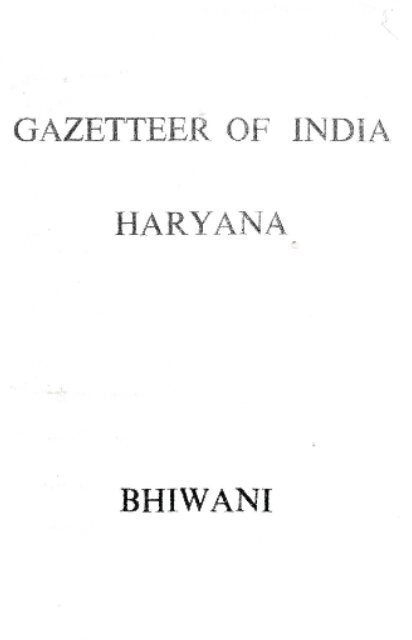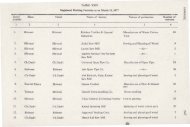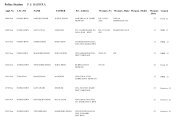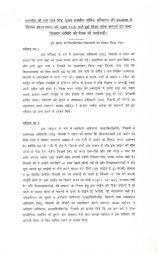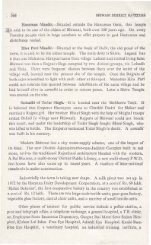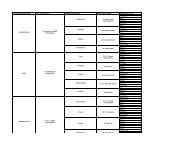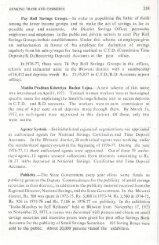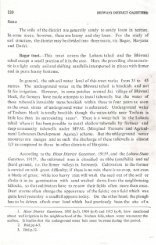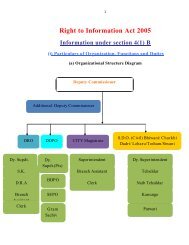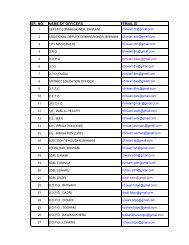chapter-i - revenue and disaster management department, haryana
chapter-i - revenue and disaster management department, haryana
chapter-i - revenue and disaster management department, haryana
You also want an ePaper? Increase the reach of your titles
YUMPU automatically turns print PDFs into web optimized ePapers that Google loves.
GAZETTEER OF INDIA<br />
HARYANA<br />
BHIWANI
I-IAR' A DISTRICT GAZETTEERS<br />
.BHIWANI<br />
HARYANA GAZETIEERS ORGANISATION<br />
REVENUE DEPARTMENT<br />
CHANDIGARH (India)<br />
1912<br />
SUNIL AHUJA. lAS,<br />
State Editor (Gazetteers)<br />
"B.RAJ BAJN<br />
Editor
Tile 'outroll 'f, Printing a.nd Stationery,<br />
HaryaOI. Ch<strong>and</strong>igarh (India)<br />
Printed by :<br />
Controller of Printing an:! Stt.tionery.<br />
G():vernment of Haryana•.ChanJigarh .
Thi is thefirstgazetteer of the Bhiwani district which<br />
was created in December 1972.Thegazetteer contains useful<br />
information on important aspects of district life. The<br />
development in this arid di trict after the formation of<br />
Haryana has been phenomenal, plfticularly with the<br />
introduction of a network of canals through lift irrigation<br />
schemes. Introduction of irrigation in the centuries old<br />
desert tract is fast changing the lives of ~the people. The<br />
<strong>chapter</strong>s in this compendium have been so devised as to<br />
make the gazetteer useful to those engaged in administration,<br />
welfare programmes <strong>and</strong> research. The work, it is hop~d,<br />
will also be ofinterest to the general reader.<br />
Compliments are due to the Gazetteers Unit ~forhaving<br />
prepared such a voluminous work in a short period. I am<br />
thankful to Shri E.N. Mangat Rai <strong>and</strong> Dr. K.C. Khanna who<br />
revised the draft of the gazetteer.<br />
Ch<strong>and</strong>igarh,<br />
13thMay, 1982<br />
Financial Commissioner Revenue <strong>and</strong><br />
Secretary to Government, Haryana,<br />
Revenue Department.
. .. ... -.,-<br />
. .. .../ .• Jd.U<br />
Til) G.E)tte~r of Bh.1wam IS th) tha'd 1Q SUCCes.SlO f<br />
th." district glZ·~tteers so far brough~ out by th) H·:lry.:l.!1~<br />
G)v~rnmmt. This district wasform~d in D~cemb~r ~91i.})l<br />
integll.ting c)rtain t~rritories which p:~vloU3ty form)~: y.~r)f<br />
of two sep:uate districts. Bhiwani <strong>and</strong> Bawani .I(.~era)wjr~<br />
p:.ut of the Hisar district together with Loharu, ~ r~rm~J<br />
princely state. D.ldri, which at one tim~ belon!?ed:,;to 19.f<br />
erstwhile p::-incelystate of lind, came to Bhiwani fro~ !i~<br />
Mahendragarh district. : ,..) r ..tfJ.>I<br />
1 ~cessarily rdiance hid to b~ placed on old ga:zetteeffl,<br />
p.lrticularily of th~ Hisar district, for much of t1:pm:werial.<br />
Th~ Lohlru State G3.z~tteer, 1915 <strong>and</strong> th) Phulkfaq"~§t,,t8<br />
Gazetteer, 1904 w~re of imm;nse help. H:>wevtr~)tl?ast<br />
Indep;ndence developm)nts, espeCIally . aftee t h ~ creation . ~uf 0<br />
Haryana, had tobeincorpJrated from numeroU$ sources <strong>and</strong><br />
publications bJth of th; G:>vernm)nt <strong>and</strong> p::-ivatebodies. In<br />
the absence of relevant infonnltion many spot studies also<br />
had to be conducted.<br />
The introduction of canal irrigation in this seiifig~Nt~<br />
region is the singular IUOstsignificant transf~8:natl&IllIwHfch<br />
has taken place in recent years. Hence this gazetteer is not<br />
only a geographical <strong>and</strong> historical record but also tries to<br />
capture most of the major changes brought out by the<br />
development pro;;;ss. Its r~f~r~nc~ date, unless sp3cifically<br />
stated in thetext otherwise, is March 31, 1977.<br />
~.<br />
The writing <strong>and</strong> publication of'ta, nev\n'lgazetteeris atask<br />
involving mlny p~ople while it isn)tp)3si~.1~,to acknowledge<br />
eachof their contributbns individually sp~cial mention must<br />
be made of those who w~repdmarily resp:>nsible. My th:mks
are due to B. Raj Baja';, fomlerly Editor in the State<br />
Gazetteers Unit <strong>and</strong> his team ofResearch Officers S.P.Dheer,<br />
A.K. Jain _<strong>and</strong> Krishna Chakarvarti. S.P. Kainth, R.K.<br />
Malhotra <strong>and</strong> Tej Bhan, staff membels of. the [Gazetteers<br />
Unit also provided valuable assistance. lDr. K.C. Yadav,<br />
Kurukshetra University wrote the <strong>chapter</strong> OIl; History,<br />
Df.ICC. Khanna provided' expert comments. B.K. Kathpalia<br />
of the Haryana Develcpment Departmentp repared the maps.<br />
R.K. Sharda, formerly' District Public Relations Officer,<br />
Bhiwani was of great help during field visits. E.N. Mangat<br />
Rai, ICS (Retd.), was kind enough to go through the entire<br />
manuscript <strong>and</strong> make several improvements.<br />
Written on a pattern fprescribed by the Government<br />
ofIndia, it is hoped that this gazetteer would be of some<br />
use to both researchers <strong>and</strong> general ~readers alike.<br />
Ch<strong>and</strong>igarh,<br />
13th May, 1982<br />
State Editor (Gazetteers) <strong>and</strong><br />
[Joint Secretary to Government, Haryana.<br />
Revenue Department.
Origin of the nameofthe district<br />
Location, boundaries, area <strong>and</strong> population<br />
Location <strong>and</strong> boundaries-I,<br />
Area-I, Population-2<br />
History ofthe district as an<br />
administrative unit<br />
Topo~raphy<br />
Natural drainage, rivers <strong>and</strong> other surface<br />
water resources<br />
Mammals-I8, Birds-I9,<br />
Birds of economic importance-20,<br />
Reptiles-'-2I, Fishes-23<br />
Olimate<br />
Temperature-23, Humidity-24,<br />
RainfalI-24, Clouds-25.<br />
Winds-25, Special weather<br />
phenomena-25<br />
The ancient period<br />
The medieyal period<br />
The modern period<br />
1-2S<br />
27-40<br />
27<br />
30<br />
1<br />
1<br />
34
Religious groups-45, Superstitions-49,<br />
Festivals <strong>and</strong> fairs-50<br />
Socialgroups-52, Joint family<br />
system-59, Iuheritance-60,<br />
Marriage customs-62, Other rituals<br />
a!ldcustoms-68, Position of women-69<br />
Villages-7l, Dwellings,<br />
furniture <strong>and</strong> utensils-n,<br />
Dress <strong>and</strong> ornaments-74,<br />
Food-76<br />
Folk culture-77, Games <strong>and</strong><br />
recreation-80<br />
Refugee camps-82, Rural rehabilitation-83, Urban<br />
rehabilitation-84, Smallurban <strong>and</strong> house-building<br />
loans-85, Payment of compensation-86, Impact<br />
of displaced persons on local population-8?<br />
Irrigation<br />
Canalirrigation in the district prior to the formation<br />
of Haryana-93, Progress after theformation of HarylUla<br />
State-96, Newcanal irrigation schemes-98, Well<br />
irrigation-108, Tank irrigation-Il2, Minor irrigation<br />
(ground water exploration <strong>and</strong> development)-l12,<br />
Lining of kachcha watercourses-lIS, Cloud-seeding<br />
experimental operations for inducing artificial<br />
rainfall-117<br />
41-87<br />
41<br />
44<br />
89-173<br />
89
Agriculture<br />
Set-up of the agriculture <strong>department</strong>-lI8, Soils-120,<br />
Crops-125, Fodder crops-128, Horticulture-l30,<br />
Agricultural implements-131, Mechanised farming-l33<br />
Seed-I36, Manures<strong>and</strong> chemical fertiIizers-137,<br />
Agricultural pests <strong>and</strong> diseases-l39, Marginal Farmers<br />
<strong>and</strong> Agricultural Labourers Development Agency (MFAL),<br />
Bhiwani-140, Agricultural cooperatives-146<br />
Animal Husb<strong>and</strong>ry<br />
Cattle <strong>and</strong> buffaloes-150, Intensive Cattle Development Project,<br />
Bhiwani-151, Dairy farming-152, Sheep breeding-153,<br />
Piggery-,153, Camels-153, Horses <strong>and</strong> ponies- 153,<br />
Donkeys-.153, Animal diseases <strong>and</strong> veterinary hospitals-153,<br />
Slaughter houses-15ot, Poultry development-155, Problem of<br />
strllYanimals-155, Gaushala development-155<br />
Forestry<br />
Natural calamities (Famine <strong>and</strong> drought)<br />
Common facility centres<br />
Marke"ting assistance<br />
Industrial areas<br />
Commercial banks<br />
Rural industries project<br />
Industrial training<br />
Source of power<br />
Industries <strong>and</strong> manufacturell<br />
Large <strong>and</strong> medium-scale industries-194. Small-scale<br />
industries-204, Cottage industries-204<br />
Regiltered factories<br />
Industrial labour<br />
Cooperative movement<br />
155<br />
157<br />
165<br />
175-208<br />
175<br />
182<br />
183<br />
187<br />
188<br />
189<br />
189<br />
190'<br />
191<br />
192<br />
193<br />
205<br />
205<br />
206
Money-lenders <strong>and</strong> agricultural indebtedness<br />
Cooperative credit<br />
Central cooperative bank<br />
Primary l<strong>and</strong> deTelopmcnt banks<br />
Joint-stock banks<br />
Regional Rural Bank, Bhiwani<br />
Insurance<br />
Small savings<br />
School savings bank (Sanchayika) scheme-218, Pay roll<br />
savingsgroups-219, Mahila pradhan kshetriya bachat yojna-219,<br />
Agency system_219, Publicity-219<br />
Currency <strong>and</strong> coinage<br />
Trade <strong>and</strong> commerce<br />
Regulated markets<br />
Cattle fairs<br />
Stat~ trading<br />
Weights <strong>and</strong> measures<br />
Storage <strong>and</strong> warehousing<br />
CHAPTER VII_COMMUNICATIONS<br />
Roads<br />
National highway-238, State [highways-238,<br />
Other roads- 239,Road beautification programme-239,<br />
Canal inspection roads-240<br />
Vehicles <strong>and</strong> conveyances<br />
Passanger transport-240, Goods transport byroad-245,<br />
Railways-246, Transport by air-248<br />
Facilities for travellers<br />
Post offices<br />
208<br />
... 209-233<br />
209<br />
211<br />
213<br />
214<br />
214<br />
216<br />
217<br />
217<br />
220<br />
220<br />
222<br />
226<br />
227<br />
229<br />
232<br />
232<br />
•.• 235-255<br />
235<br />
248<br />
249
Telegraphs<br />
Telephones<br />
CHAPTER VIII-MISCELLANEOUS. OCCUPATIONS<br />
Educational personnel<br />
Engineering services<br />
Transport<br />
Personal services<br />
Barbers-275. Washermen-275. Tailors-276<br />
Livelihood pattern<br />
Employment situation<br />
Employment exchanges-286<br />
Wages<br />
Community development<br />
DistriGt authorities<br />
Deputy Commissioner-307. Sub-Divisional Officer-309.<br />
Tahsildar (Mahal)/Naib TahsiIdar (Mahal)-309<br />
General arrangement fordisposal of business<br />
General Assistant-31l. Additional General Assistant to<br />
Deputy Commissioner-312<br />
Other State <strong>and</strong> Central governmen~ officers<br />
State government officers-313, Central government officers<br />
(excluding military officers)-316<br />
253<br />
254<br />
... 257-281<br />
283-304<br />
283<br />
257<br />
259<br />
271<br />
272<br />
274<br />
275<br />
278<br />
278<br />
288<br />
298<br />
301<br />
... 305-318<br />
305<br />
307<br />
312<br />
313
Development organization<br />
Police<br />
Judiciary<br />
District Attorney<br />
Oath Commissioner<br />
CHAPTER XI-REVENUE ADMINISTRA nON<br />
History ofthe <strong>revenue</strong> administration<br />
Specialassessment onl<strong>and</strong> put tonon-agricultural use-328,<br />
The Punjab L<strong>and</strong> Revenue (Surcharge) Act, 1954-329,<br />
Adhoc SpecialAssessment under Punjab L<strong>and</strong> Revenue Act,<br />
No.6 of 1956-329, The Punjab L<strong>and</strong> Revenue (Special<br />
Charges) Act, 1958-329, Punjab Revenue Act XIX<br />
of 1958-329<br />
Other enactments<br />
Haryana L<strong>and</strong>-Holdings Tax Act, 1973-332<br />
L<strong>and</strong> <strong>revenue</strong><strong>and</strong> special cesses<br />
L<strong>and</strong> <strong>revenue</strong>/l<strong>and</strong>-holding tax-34/, Specialcesses (Village<br />
officers' cess-342, Local rate-342, Water rates-343,<br />
Betterment charges--343)<br />
L<strong>and</strong> reforms<br />
Consolidation ofholdings<br />
Other sources of <strong>revenue</strong>, State <strong>and</strong> Central<br />
State sources of<strong>revenue</strong>-359, Central sources of <strong>revenue</strong>-372<br />
CHAPTER XII-LAW AND ORDER AND JUSTICE<br />
Incidence of crime<br />
Police<br />
Jails<br />
Justice<br />
Public Works Department<br />
Public Health Engineering-407, Buildings <strong>and</strong> Roads-408,<br />
Irrigation-41O<br />
316<br />
317<br />
317<br />
317<br />
318<br />
318<br />
318<br />
318<br />
319-374<br />
319<br />
336<br />
338<br />
341<br />
343<br />
357<br />
359<br />
375-406<br />
375<br />
387<br />
396<br />
399<br />
407-428<br />
407
Haryana State Electrtcity Board<br />
Coopec:tive Department<br />
Depntment of Welfare of Scheduled Castes <strong>and</strong><br />
Backward Classes<br />
Finance Deparment<br />
Public Relations Department<br />
Fire Fighting Department<br />
Food <strong>and</strong> Supplies Department<br />
Planning Department<br />
National Savings Organization<br />
Departments of Town <strong>and</strong> Country Planning, Haryana<br />
Urban Development Authority <strong>and</strong> Colonization<br />
Krishi Gyan Kendra, Bhiwani (Haryana Agricultural<br />
University)<br />
Urb:lll local government<br />
Historical background-429. Municipalities (Bhiwani-429,<br />
Cbarkhi Dadri-432), Notifiod area committees (Loharu-435.<br />
TOiiham- 436, Siwani-437. Bawani lChera-438)<br />
Rural local government-Panchayati Raj<br />
Panchayats-440, Panchayat Samitics-442. ZiJaParishad-444<br />
CHAPTER XV-EDUCATION AND CULTURE<br />
Historical background<br />
Education of women<br />
Education of Scheduled Castses <strong>and</strong> Backward Classes<br />
Literacy<br />
Educational set-up<br />
Medium of instruction<br />
Incentives<br />
Colleges(including technical <strong>and</strong>professional)<br />
Technical schools<br />
Oriental schools<strong>and</strong> colleges<br />
Adult literacy <strong>and</strong> socialeducation<br />
Educa.ion ofthephysically h<strong>and</strong>icapped<br />
416<br />
417<br />
420<br />
420<br />
421<br />
421<br />
422<br />
;423<br />
424<br />
427<br />
.. 429-444<br />
429<br />
445-463<br />
445<br />
448<br />
449<br />
450<br />
451<br />
452<br />
452<br />
453<br />
458<br />
460<br />
4tH<br />
461
National Cadet Corps<br />
Sports<br />
Libraries<br />
Education infine arts<br />
CHAPTER XVI-MEDICAL AND<br />
SERVICES<br />
Medical <strong>and</strong>health services<br />
Diseasescommon to the district<br />
Vital statistics<br />
General st<strong>and</strong>ard ofhealth<br />
Preventive measures to promote public health<br />
Water-supply (rural)<br />
Water-supply (urban)<br />
Sewerage (urban <strong>and</strong> rural)<br />
CHAPTER XVII-OTHER SOCIAL SERVICES<br />
General<br />
Labour welfare<br />
Labour legislation-512, Industrial relations-513, Works committees-513.<br />
Strikes-513, Trade unions-513, Subsidized Industrial Housing<br />
Scheme-514, Government Labour Welfare Centre, Bhiwani-515,<br />
Employees' Provident Funds Scheme-515, Family Pension-cum-<br />
LifeAssurance Scheme, 1971-516 Deposit-Linked Insurance Scheme,<br />
1976-517, Employees' State Insurance Scheme-517<br />
Social welfare<br />
Old agepension-518<br />
Advancement ofbackward classes<br />
Haryana Harijan Kalyan Nigam Limited<br />
Prohibition<br />
Charitable organi~tions<br />
CHAPTER XVIII-PUBLIC LIFE AND VOLUNTARY<br />
SOCIAL SERVICE ORGANIZATIONS<br />
Representation of the district in the Union <strong>and</strong><br />
State Legislatures<br />
Lok Sabha-House ofPeople (First General Elections,<br />
1952-537, Second General Election~, 1957- 537,<br />
Third General Elections, 1962-538, Fourth General<br />
Elections, 1967-539, Fifth Gneral Election~, 1971-540,<br />
Sixth Gegeral ElactioRs, 1977-541), R,ajra Sabha (CoWlcil<br />
461<br />
462<br />
463<br />
463<br />
465-5O~<br />
467<br />
480<br />
486<br />
493<br />
494<br />
503<br />
506<br />
509<br />
511-535<br />
511<br />
511<br />
51~<br />
524<br />
525<br />
528
ofStates)-542, Vidhan Sablla-Legisll\tive Assembly (First<br />
General Elections, 1952-542, Second GenllJal Blectipnl,<br />
1957_543, Third Genera1 Elections, 1.962---643,FouAb<br />
General Elections. 1967-544,Mid-Ten;.~ EleetiOllS.I96I-545,<br />
Fifth General Electiooi, 19'n-S45.Sixth Goneta~Elections,<br />
1977-546 fn)<br />
Political parties <strong>and</strong> organizations<br />
Newspapers <strong>and</strong> periodicals<br />
Voluntary S9cia1service organizations<br />
CHAPTER XIX-PLACES OF INTEREST<br />
Bawani Khera-563, Bhiwani-564, Charkhi Dadri~567,<br />
l'aliana_569, Loharu-569, Mitathal-571, Siwaai-572,<br />
Tosham-573<br />
APPENDIX<br />
Contents ofTables-577, Tables I to XLYlII-580 to 701<br />
-=BIBLIOGRAPHY<br />
GLOSSARY<br />
INDEX<br />
546<br />
S~<br />
551<br />
563-575<br />
703-706 ;<br />
707-710<br />
711-727
(x)<br />
ILLUSTRATIONS<br />
Plate 1- Stone Implements: ring stone, hammer stone, etc., <strong>and</strong><br />
Plate 2- Copper Objects : riugs, celt, parsu; found in excavations<br />
at Mitathal-:- indicative of habitation at the site during<br />
Pre-Harappan to Late-Harappan times<br />
Rock inscription of 4th-5th centuary A.D., Tosham Hill<br />
Rural mela at village Nakta (tahsil Bhiwani)<br />
Beginnings of the gigantic effort to bring water to the thirsty<br />
arid l<strong>and</strong>s of theBhiwanidistrict<br />
Water flowsin one of the newly constructed channels to slake<br />
the thirst of'the arid l<strong>and</strong>s in the Bhiwani district<br />
Water being lifted through a pump house - a special feature<br />
ofthe Lift Irrigation System<br />
Bnergisationoftubewells<br />
MilkPlant, Bhiwani - a symbol ofwhite revolution<br />
Vaish College, Bhiwani<br />
Government College, Bhiwani<br />
Bringing of drinking water fromfar away places - an essential<br />
part ofliving pattern that existedprior tothe establishment of<br />
Bapora Water Works inthe seventies of thepresent century<br />
A panoramic view of Bapora Water Works - biggest rural<br />
\Vater-supply project<br />
Drinking water goesto villagesthrough taps<br />
Old pakka tanks with covered storage wells(kunds) forcoIlecting<br />
rain water for drinking (village Pokharwas) - now athing of<br />
the past<br />
Bhiwani Water Works - anaerial view<br />
Gauri Shankar M<strong>and</strong>ir, Bhiwani<br />
Dorothy Villa atCharkhi Dadri built by the Maharaja of<br />
erstwhile princely State ofJind - now PWD rest house<br />
Newly built 19-suitePWD Rest House, Bhiwani<br />
Shyamesar Tank, Charkhi nadri<br />
Tosham Hill- resembling asleeping camel<br />
MAPS (General, IrrigatioD)<br />
729<br />
730<br />
731<br />
734<br />
735<br />
736<br />
737<br />
738<br />
740<br />
741<br />
742<br />
743<br />
744<br />
745<br />
.. 745<br />
.. 746<br />
,. 746
Bhiwani, one of the eleven districts! of Haryana State, came into<br />
existence on December 22, 1972, <strong>and</strong> wasformally inaugurated on JailUary 14,<br />
1973. It is mmed after the headquarters. town of Bhiwani, believed to be a<br />
corruption of the word Bhani. From Bhani, itchanged to Bhiani <strong>and</strong> then<br />
Bhiwani. Tradition hasitthat oneNeem,aJatu Rajput, who belonged tovillage<br />
B:twani 2 , then inHansi tahsil of the Hisar (Hissar) district, came to settle at<br />
Kaunt, avillage near the present town of Bhiwani. This was resented by the<br />
local Jat inhabitants, <strong>and</strong> they plotted his murder. Neemwas warned by a Jat<br />
woman, named Bahni, <strong>and</strong> thus forewarned, had hisrevengeonthe localJats.<br />
He killed m~st of them at a banquet, the site ofwhich was mined with gunpowder.<br />
He m'lrried B:thni <strong>and</strong> founded a village named after her. At<br />
the beginning of the nineteenth century, Bhiwani was an insignificant village<br />
inthe Dadri pargana, under the control ofthe Nawab ofJhajjar. It is,however,<br />
referred to asatown whenthe British occupied it in 1810. 3 It gained<br />
importance during British rule when in 1817, it was selected for the siteof a<br />
m<strong>and</strong>i or free market, <strong>and</strong> Charkhi Dadri, still under the Nawabs, lost its<br />
importance as a seat of commerce.<br />
Location <strong>and</strong>boundaries.- The district ofBhiwani liesinbetweenlatitude<br />
2&019' <strong>and</strong> 290 OS' <strong>and</strong> longitude 750 28' to 760 28'. It isbounded in the<br />
north by the Hisar (Hissar) district, inthe east bythe Rohtak district, inthe<br />
south by the M'lhendragarh district of Haryana <strong>and</strong> theJhunjhunu district<br />
of Rajasthan <strong>and</strong> in the west by the Churu district <strong>and</strong> a part of the<br />
Jb:unjhunu district of Rajasthan.'<br />
Area.-With an area of 5,090square kilometres, Bhiwani isthe second<br />
1. The twelfth district of Faridabad hasbeen created on August 15. 1979.<br />
2. Arnin Ch<strong>and</strong>. Tawarikh -i-Zila Hisar. 1866. p.lS. Bawani is apparantely Bawani<br />
Mera. now the headquarters ofatahsil ofthe same name inthedistrict.<br />
3. Hisar District Gazetteer. 1892,pAl.<br />
4. S()ur~e: Survey OfIndia, North Westem Circle, Ch<strong>and</strong>il?arh.
largest district inthe State following Hisar (Hissar). It comprises four tahsils<br />
covering the areas shown below l :<br />
1,470.33<br />
.1,032.86.<br />
r,42L25<br />
1,165.56<br />
5,090.00<br />
4.51<br />
·2,59<br />
is.76<br />
1,458.67<br />
1,032.86<br />
1,416.74<br />
1,162.97<br />
5,071.24<br />
Population.~The district assuchwasnot inexistence atthe last Census<br />
of 1971 <strong>and</strong> separate population data have'not been published. However,<br />
the p::>pulation, computed on the basis of the 1971 Census, was 7,61,953<br />
persons. 2 In population, it is the eighth among eleven districts of the State<br />
following Gurgaon, Hisar (Hissar), Rohtak, Ambala, K.:;strnal,Kurukshetra<br />
<strong>and</strong> Jind <strong>and</strong> st<strong>and</strong>s ahead of Mahendragarh, Sonipat <strong>and</strong> Sirsa.<br />
The first record of the administrative division now compnsmg the<br />
Bhiwani district, is found in Ain-i-Akbari. Akbar divided his kingdom into<br />
subahs, sirkars <strong>and</strong> mahals or parganas. Thewhole of what isnow the Bhiwani<br />
district wasmostly in sirkar of Hisar Firuza (principal mahals being Tosham,<br />
Seoran <strong>and</strong> Siwani)3<strong>and</strong> sirkar ofDelhi (princip;il mahal beingDadri Taha)4 of<br />
sublh Delhi. With thedecay ofthe Mughal Empire this area remained disturbed<br />
in consequence of fighting between the neighbouring chiefs till 1803,when<br />
the greaterplrtofitcam~under British rulebythe TreatyofSurjiArjungaon.<br />
Thereafter conditions sealed down. The present district has been formed by<br />
1. Source: Deputy Commissioner, Bhiwat,i.<br />
2. Statistical Abstract ofHaryana, 1975-76,p.3. (Issued bytheEconomic <strong>and</strong> Statistical<br />
Organization, Planning Department, Haryana.)<br />
3. Abul Fazl, Ain-i-Akbari, Volume II (Englishtransiation by H. S.Jarrett, comc;ted<br />
!In~further annotated bySir Jadu"nath Sarkar);1949,pp. 298-~OQ.<br />
4. Ibid, PP.791-93•.
m~rgingthreesepirate units, viZ.(i):Bhl~a~r~rid l3awaniKhera, whichformeda<br />
p:trtoftheRisar (Hissar)district ;'(ii) Dadri, whichwas formerlya part<br />
ofa princelyState<strong>and</strong>-laterofthe Mahendragarh district; <strong>and</strong> (iii)Loharu,<br />
which was a princely' State <strong>and</strong> later merged with the Hisar (Hissar)<br />
district after Independence. These three tracts have different administrative<br />
histories.<br />
The first tract consisting ofthe. twotahsils of Bhiwani <strong>and</strong> Bawani<br />
Khera, wasa part ofthe territory knownasHaryana immediately prior tothe<br />
Britishconquestin1803 <strong>and</strong>wasnominaJIysubjecttothe Marathas, whoruled<br />
itinthe name of Mughal Emperor at Delhi. Siwani<strong>and</strong> Bahlwere 2<br />
of the 19districts into which Haryana had beendivided at that time. l In<br />
'1810,thedateoftheactual establishment of.the Britishauthority inthis part,<br />
the wholeofthe Delhi territory ceded 1;'ythe Marathas wassubjectto the<br />
ResidentofD~lhi, <strong>and</strong>wasdividedintotwodistricts: Delhi,already underthe<br />
Resident, <strong>and</strong> the outlying districts including' Hansi, Hisar (Hissar), Sirsa,<br />
Rohtak, Panipat <strong>and</strong> Rewari, under the' immediate charge ofan Assistant to<br />
the Resident. In 1819,theDelhiterritory wasdividedintothreedistricts: the<br />
central district whichincluded Delhi, the southern including Rewari, <strong>and</strong> the<br />
north-western including Panipat, Hansi, Hisar (Hissar), Sirsa <strong>and</strong> Rohtak.<br />
In 1820,the latter·(north-western) was again sub-divided into a northern<br />
<strong>and</strong>a w
Jaipur authority <strong>and</strong> t'orni~danindep~ndent State. TheRaja of Khetri, a dependencyofJaipur,<br />
attempted tosubdue-thembutwasslaininbattleatLoharu.<br />
The Statewas,however,re-annexedto Jaipur foratime, butitsoon regained<br />
its independence. Subsequently it acknowledged British suzerai.nty. The<br />
Britishrulersgavethetaluk ofLoharu (73&squarekilometres)in.rewardtothe<br />
Maharaja of Alwar, whohad loyallyaided them during the 1&03campaign<br />
against the Marathas. The sanad given by General Lord Lake to Raja<br />
SiwaeeBakhtawar SinghofAlwaronthis occasion istranslated asfollows l :-<br />
"To allMootsaddies, present <strong>and</strong>future"as wdl asto Amils,Choudhrees,<br />
Kanoongoes, Zamindars <strong>and</strong> Cultivators ofParganas, Ismaeelpooro,<br />
<strong>and</strong> MJodawar withthe Talookasof Darbarpore, Rutaee, Nimrana, M<strong>and</strong>an,<br />
Ghelote, Beejwar, Suraie, Dadree, Loraroo, Boodwanah <strong>and</strong> Bhoodchalnahur,<br />
underthe Soobah of Shahjehanabad : Letit beknownthat betweenthe<br />
Honourable the East Indian CompanyofEngl<strong>and</strong> <strong>and</strong> Maharao Raja Sewaee<br />
B!lkhtawarSingh thefriendshipwhichexistedhasbeenstcengthened;therefore,<br />
witha viewofproving<strong>and</strong> makil\gthisfactpublictoeveryone, GeneralLord<br />
Lake directsthat the above-mentioneddistrict be madeoverto theMaharao<br />
Raja for his expenses,subject to the concurrence of the Most Noble the<br />
Governor-General, Lord Wellesley.<br />
"On thepermissiotlof tbe GovertlUr-General beiqg received,another<br />
Sanad willbe giveninplaceofthe p,resentone,which willberecalled.<br />
"Until another Sanad arrives, this one wtu remain inpossessioll of<br />
the Maharao Raja.<br />
"Parganas Ismaeelpore<strong>and</strong> Moodawar, withthe Talookas ofDarbarp:>re,Rutaee,<br />
Nimrana, M<strong>and</strong>an, Beejwar<strong>and</strong> Ghelote <strong>and</strong> Suraie, Dadree<br />
<strong>and</strong> Laharoo, Boodwanah <strong>and</strong> BhQOdchalnahur,.<br />
"Dated 2&thNovember, A.D. 1803, corresponding with the 12thofthe<br />
Shaban, 121&.Hijreeor AghunSood Pooranmassee, Sambat, 1&60.<br />
"(Signed)G. Lake."<br />
The Maharaja intam, with the assentofthe BritishGovernment, entrusted<br />
Loharu tohis vakeel,Ahman BakashKhan, whohad foughtgallantly<br />
onthe British side under the title Gf Nawab.= His d~cendants ruled this<br />
1. Powlett. P.W., Gazetteer01utwar,1878 (Lendon). p. 171.<br />
2. HisarDistrict<strong>and</strong>LoharuState Gazetteer (Lohar.uStat~. ~915,pp. 2.3; A/war<br />
District Gautteer, 1968, p.65.
State till it wasmerged, except 15 viliages, with the Hisar (Hissar) district<br />
under the Provinces <strong>and</strong> States (Absorption ofEnclaves) Order, 1950. 1<br />
According to the Phulkian States Gazetteer (Patiala, Jind <strong>and</strong>Nobha),<br />
1904,2 Charkhi Dadri town was formerelyinthe possession ofNawab Bahadur<br />
Jang, a relative ofthe Jhajjar Nawab. Inthe events of 1857, his estates<br />
were confiscated. Dadri area, covering nearly 600 square miles3 (1,554<br />
sqUlre kilometres) was first included inthe newly created district ofJhajjar,<br />
which was abolished shortly afterwards in 1860 when large parts ofit were<br />
assigned to the Phulkian Chiefs, asa reward for their servicesto the British<br />
Government.' Dadri was conferred on Raja Sarup Singh of Jind.5 Till<br />
1904,Dadri wasatahsil ofthe Jind district (Nizamat). In that year, Dadri<br />
tahsil wasmade into a separate district. 6 After Independence (1947),<strong>and</strong><br />
the subsequent formation of PEPSU (Patiala <strong>and</strong> East Punjab States Union)<br />
onMay 5,1948,the Dadri area ofthe Jind State wasincluded intheMahendragarh<br />
district. Under the States Re-organisation Act, 1956, PEPSU was<br />
merged with Punjab on November 1,1956, <strong>and</strong> consequently theMahendragarh<br />
district, of which Dadri was a part, became one of the then 19districts<br />
of Punjab. The four villages of the Dadri tahsil, viz. Umrawat, Ralluwas,<br />
Dharana <strong>and</strong> Rajgarh, with atotal area of 31.49 square kilometres were<br />
transferred to the Bhiwani tahsil of the Hisar (Hissar) district. The village<br />
~<br />
Umrawat was actually transferred on October, 6, 1969,while the other three<br />
villages had beentransferred on August 10,1962. 7<br />
This entire area wasincluded inthe newState of Haryana on November<br />
1, 1966. The above administrative arrangements continued till the<br />
neW district of Bhiwani comprising the Dadri, Loham, Bhiwani <strong>and</strong> Bawani<br />
Khera tahsils with headquarters at Bhiwani was constituted on December 22,<br />
1972, by varying the limits ofthe Mahendragarh <strong>and</strong> Risar districts so as<br />
to exclude th.e areas of the Dadri tahsil of the Mahendragarh district,<br />
<strong>and</strong> Loham, Bhiwani <strong>and</strong> Bawani Khera tahsils of the Hisar district.s<br />
L Census of India. 1961, District Census H<strong>and</strong>book. Hisar District, 1966.p. 11.<br />
2. Ibid. p.333.<br />
3. Ibid, p.216.<br />
4. Rohtak District Gazetteer, 1970, p. 3.<br />
5. PhulkiQJlStates -Gazetteer (Patiala, Jind <strong>and</strong> NaMa), 1904·,p. 333.<br />
'6. Phulkian States Gazetteer. Statistical Tables (find State), 1913, p. 3.<br />
7. Census of India. 1971, District Census H<strong>and</strong>book, Mahendragarh District. 1973, p.5.<br />
8. Vide Haryana Government. Revenue Department Notification No. 6050-E(IV)-72/<br />
451123, dated December 22, 1972.
The following table shows the number of villages -ineach tahsilon the eve of<br />
the formation of the Bhiwani district <strong>and</strong> thereafter :-<br />
Number of<br />
villages on<br />
the eve of<br />
December<br />
22, 1972<br />
Nil<br />
(tahsil not<br />
in existence)<br />
Number of Remarks<br />
villages on<br />
December<br />
22, 1972<br />
114 (i) 37 villages were transferred<br />
to the Loharu<br />
tahsil.<br />
(ii) 6 villages .were transferred<br />
to the Bawani<br />
KJ-..era tahsil.<br />
(iii) 9 villages were added<br />
from the Dadri tahsil.<br />
(i) 6 villages were added<br />
from the Bhiwani tahsil.<br />
(ii) 32 villa:ges were added<br />
from the Hansi tahsil of<br />
the Hisar district.<br />
(iii) 17 villages \yere added<br />
from the Hisiif tahsil of<br />
the fIisar district.<br />
(i).9 villages were trans.,.<br />
ferred to the Bhiwani<br />
tahsil.<br />
(ii) 20 ,villages were .added<br />
from the Mahep.dragarh<br />
tahsil of the Mahendragarh<br />
dj..strict. .<br />
(i) 2 villages were added<br />
from the Mahendragarh<br />
tahsil of the Mahendragarh<br />
district:' ,<br />
(ii) 37 villages were added<br />
. .. frOJ:.n.t4e Bhiwani t~hsiL
OnApri123, 1974, 12villages (Jarwa, Basri, Sohari, Nanwan, Nanga1<br />
- . -<br />
Mala, Satnali, Birsingwas, -SuretiJhakaf, Sureti Pilania, Sureti Maveryana,<br />
phana <strong>and</strong> Bas) were transferred from the Dadri tahsil tothe Loharu tahsil.<br />
.5villages (Nimriwali, Pahladgarh, N<strong>and</strong>gaon, Rupgarh <strong>and</strong> Madh Mathvi)<br />
.wereincluded in the Bhiwani tahsil from the Dadri tahsil. One village, Indiwali,<br />
was also included in the Bhiwani tahsil from the Loharu tahsiJ.1 On<br />
the Slme day, 3 villages ofthe Dadri tahsil (Bhurjat, Kharkhara <strong>and</strong> Adilpur)<br />
were incorpJrated in the Mahendragarh tahsil of the Mahendragarh<br />
district; 5villages ofthe M'ihendragarh tahsil (Barda, Dalanwas, Gadarwas,<br />
Madogarh <strong>and</strong> Degrota) were transferred to the Loharu tahsil <strong>and</strong> 1village,<br />
Nasuha, of the Mlhendragarh tahsil was transferred to the Dadri tahsiI.2<br />
OilJune 11,1974,5 villagesofthe Loharu tahsil (Isharwal, Dewawas, Rodhan,<br />
Salhawahi <strong>and</strong> Hasan) were included inthe Bhiwani tahsil <strong>and</strong> 3 villages<br />
(Kakral, Sewani<strong>and</strong> Naloi) inthe Bawani Khera tahsil. 3 Thus the Bhiwani<br />
district, on March 31, 1977, comprised 474 villages, divided between tahsil<br />
Bhiwani: 125,tahsil Bawani Khera :58,tahsil Dadri: 172<strong>and</strong> tahsil Loharu :<br />
119.<br />
SUB-DIVISIONS, TAHSILS AND THANAS<br />
The district has 4 tahsils :Bhiwani, Bawani Khera, Dadri <strong>and</strong> Loharu.<br />
Sub-divisions were created at Bhiwani, Dadri <strong>and</strong> Loharu on September 3,<br />
1954,September 4, 1968<strong>and</strong> November 10,1976 respectively. The Bawani<br />
Khera tahsil is under the Sub-Divisional Officer, Bhiwani.<br />
There are 9 thanas(police stations) <strong>and</strong> 8police posts. 4 Details may<br />
be seenin the Chapter on 'General Administration'.<br />
TOPOGRAPHY<br />
According to the Hisar District <strong>and</strong> Loharu State Gazetteer (Hisar<br />
District), 1915,the general aspect ofthe district, (which included much of the<br />
present B~iwanidistrict), m1ybedescribed asalevelplain orprairie, stretching<br />
from the north-west to the south east, <strong>and</strong> unbroken byany natural irregularity,<br />
except in the south-western corner where some of the detached peaks<br />
1. Vide Haryana Government, Revenue Department Notification No. 2278-RIV-74/<br />
11546,dated April 23, 1974.<br />
2. Vide Haryana Government, Revenue Department Notification No. 2278-RIV-74/<br />
11547,dated April 23,1974.<br />
, 3. Vide Haryana Government, Revenue Department Notification No. 3059-RIV-74/<br />
19359, dated June 11, 1974.<br />
4. The police post of Bahl having been up-graded as police station on April 1 1977,<br />
there arenow 10 police stations <strong>and</strong> 7policeposts. _- --,
of theAravalli range st<strong>and</strong> out against the horizon. The highest ofthese is<br />
the Tosham hill, 800 feet(244 metreS)high. As<strong>and</strong>y tract stretches down the<br />
western portion ofthe district tillthe Bhiwani area is entered, wherethe district<br />
presents the appearance ofaseaof s<strong>and</strong>y billows ofamore or less fluctuating<br />
nature. The whole of the Bhiwani tahsil, leaving out a smallportion<br />
inthe east whichwasapart oftheso-called Haryana tract, was known as<br />
Bagar. Here the prevailing characteristic is a light s<strong>and</strong>y soil <strong>and</strong> shifting<br />
s<strong>and</strong>-hills interspersed in places with firmer<strong>and</strong> inpart loamy bottoms. The<br />
s<strong>and</strong>-hills are known astibbas<strong>and</strong> the firmer valleysbetween as tals. 1<br />
As regards the Loham tahsil, "The aspect ofthe country isuniform<br />
throughout the State. It presents a prospect, dreary <strong>and</strong> d~solate, a treeless<br />
waste dotted with s<strong>and</strong>-hills, <strong>and</strong> sparsely covered with vegetation. No<br />
natural divisions can be said to exista,ndthe hill system.ificomprised intWQ<br />
hills which rise in rocky isolation inthe centre ofthe State."2<br />
As regards the Dadri area, according to the Phulkian States Gazetteer<br />
(Patiala,find <strong>and</strong> Nabha), 1904,3 itlayin Haryana tract <strong>and</strong> Badhara in the<br />
Bagar which was acontinuation ofthe Bagar ofthe Bhiwani tahsil, though<br />
water was50to 54 feet(15to 16.5metres) belowthesurface.<br />
As regards the river system inthe Dadri tahsil the Phulkian States<br />
Gazetteer(Patiala,find <strong>and</strong> Nabha), 1904, records that "Tahsil Dadri, which<br />
has no canal irrigation, iswatered bythe Dohan, a stream which rises inthe<br />
l<strong>and</strong>s of Ghoghu <strong>and</strong> Bhagaur, two villages of the Jaipur State, whence it<br />
flows past the Patiala town ofKanaud <strong>and</strong> thereafter irrigates the Jind villages<br />
ofPalari, Badhwana, Jawa, Jhojhu Kalan, Balali, Abidpura, M<strong>and</strong>ola, Kaliana<br />
<strong>and</strong> Dadri for some 15 or 16miles (24 or 26 kilometres), disappearing inthe<br />
dakar l<strong>and</strong> of kalyawas (Kaliawas) in Rohtak. When in flood in the rainy<br />
season, itis used tofertilize thel<strong>and</strong>s belowitslevelfor two orthree years, but<br />
itwas apt inyears ofheavy rainfall tocause damage both to houses <strong>and</strong> crops,<br />
<strong>and</strong> is now controlled by three dams, of which the first, raised in 1874, lies<br />
between the roads leading from Dadri to Kaliana <strong>and</strong> Jhajjar, whilethe second<br />
isbetween those leading to the Dadri railway station <strong>and</strong> the Johawala tank<br />
near the town, <strong>and</strong> the third, made in 1886, adjoins Dadri station, lyingbetweenthe<br />
road leading from the town to Rawaldhi <strong>and</strong> that leading from<br />
the town to the Station. The worst floods occurred in 1862 <strong>and</strong> 1885. In<br />
the latter year considerable damage was done in the town of Dadri both to<br />
1. Ibid,pp.2,4.<br />
2. Hisar District <strong>and</strong> Loham State Gazetteer (Loharu Stq.te), 19{5. p..1.<br />
~. lhili, p. 214.
priVateproperty 3_ndtothe State Khata.~orgrain stores, whichwere destroyed.<br />
The lossto the ~tate alone was estimated at a lakh of rUpees. The b<strong>and</strong>s,<br />
whichkept th~water ofthe Dohan from entering the town, alsoprevented the<br />
surface drainage ofthet0wn itself from findingan outlet, <strong>and</strong> thus injury tothe<br />
place resulted."l<br />
The waters ofDohan have,however,ceasedtoflowintothe Dadri tahsil.<br />
At least since 1947,no floods from tbis stream have afflictedthis tahsil. The<br />
stream gets a.bsorbed in the arid il.nd s<strong>and</strong>y tract of Mahenrlragarh district<br />
<strong>and</strong> completdy vanishes near villagesAkodah <strong>and</strong> Bassiwhich are situated on<br />
the Narna'll-Mlhendragarh-Dadri Road close to the north~rn border ofthe<br />
Mahendragarh district.<br />
The newly carved out district occupies a transitional position between<br />
the fairly flat <strong>and</strong> featureless Punjab-Haryana Plains onthe one h<strong>and</strong>,<br />
<strong>and</strong> the Rajasthan desert <strong>and</strong> the Aravalli hills on the other. Amajor portion<br />
of this transitional tract is a s<strong>and</strong>y, undulating plain dotted with<br />
s<strong>and</strong>-dunes of varying shapes <strong>and</strong> dimensions occurring in different directional<br />
dispositions. The monotony of the s<strong>and</strong>y plain is broken in parts<br />
by the hills which once were a part of the Aravalli mountain system,<br />
one of the oldest in the country. The north-eastern part of the district,<br />
by contrast, isa fairly flat plain. The highest point in" the district is 1,470<br />
feet(44&metres) above sealevelnear Kaliana inthe Dadri tahsil. The general<br />
topography of the district bears distinct imprint of the influence of both wind<br />
<strong>and</strong> water. In severalparts ithas thecharacteristics ofdesert topography <strong>and</strong><br />
arid l<strong>and</strong>scapes. This isalso confirmed inthe term 'Bagar' which isaclimatic<br />
term indicating arid conditions. Ofthe districts comprising the State of<br />
Haryana, Bhiwani comes next to Gurgaon <strong>and</strong> Mahendragarh in physiographic<br />
diversity.<br />
A closeexamination ofthe relief ofthearea reveals afourfold division<br />
of the district into physiographic units :<br />
(i) the north-eastern part, which isfairly flat;<br />
(ii) the central <strong>and</strong> north-western zone with a fair spread oflowhills<br />
of different dimensions, occurring in varying directions, <strong>and</strong><br />
interspersed by s<strong>and</strong>-dunes in parts;<br />
(iii) the s<strong>and</strong>y triangular zone enclosed by Bhiwani, LoharU <strong>and</strong><br />
Jhumpa; <strong>and</strong>
BHIw ANI DISTRICf GAZ~~~E~~<br />
(iv) the eastern 'lnd north--ea3terI)..part ofthe.I?adri tah~i1wlljcll,b_as<br />
~ .- .•.. _._~~. _._".~.#' .• ~,... ~.' ,." ..• ", f" ••.•.. r. \ ~r<br />
., ·a mixtu.reofplain ap_.dhilltopography,.th~~i11s bliadicin-~occurrehce.· -- ., , .. ,. '- -" .-<br />
(i) The North-eastern ZC?ne<br />
This zone includes n large part of the Bawani Khera ·tahsil <strong>and</strong> the<br />
north-eastern section oftheBhiwani·tahsil.' It is·generally fiat,with anortheast<br />
to south-west inclir.ation.. The southern <strong>and</strong> south-western limits oft1>.is<br />
top::>graphicunitare ID'irkedbythetermination ofdistributarie3 ofthe Western<br />
Yamum (Juffina) C-?,nalSy;tem, The predominance. ofhills arid s<strong>and</strong>-dunes<br />
westof this zone (i)versethe inclimtion ofthe l<strong>and</strong> cpar8.cteristic oLthe:canal<br />
irrigated area. The area north-east of the Bhiwani-Db Rmiyan (Dhamana)<br />
axis ispractically flat <strong>and</strong> presents a plain's l<strong>and</strong>s~~pe.<br />
---~.-.-<br />
Throughout this belt the altitude ranges between 695 <strong>and</strong> 741 feet<br />
(212 <strong>and</strong> 226 metres) above seaievel. However, there i-;a:stray occurrence of<br />
s<strong>and</strong>-dunes evenhere; suchasnear villagesBaliyali<strong>and</strong> Badesra intbe Bawani<br />
Kbera tahsil, <strong>and</strong> near villages Chang <strong>and</strong> Rewari inthe Bhiwani tahsil.<br />
(ij) The Central <strong>and</strong> North-western Zone<br />
Thiszoneispractically enclosed bythe linesjoining theplaces: Tosham-<br />
B'ljina-Rodha-Jhumpa-Gurera-Barwa-Dhamiyan (Dha.mana)- Tosham. The<br />
characteristic feature ofthe topography isthe relictype ofhills occqrring all<br />
oVerthe area. These hills arepHt ofthe old Aravalli mountain sY5
of·the adjoining Rajasthan desert. 'this 30neisci~stered with s<strong>and</strong>-dune sof<br />
varying shapes.<strong>and</strong> dimensions. In between the s<strong>and</strong>-dunes ar~ fairly level<br />
s<strong>and</strong>y surfaces which constitute the main agricultural l<strong>and</strong>. Of course, the<br />
general top0graphy ismarked byirregularities <strong>and</strong> undulations. Thedirection<br />
ofthe s<strong>and</strong>-dunes isinconsistent. The general altitude ofthis tract varies between<br />
750 <strong>and</strong> 870 feet (229<strong>and</strong> 265 metres). However, there isahillypoint<br />
called 'Pabari' which is 1,064 feet (324 metre.s). The s<strong>and</strong>-dunes, which are<br />
quite closely spaced, repnsent an extension ofthe lan.dscape across tbe State<br />
borde1fin Rajasthan.<br />
This tract includes the eastern part of the Dadri tahsil. It is a true<br />
transition betw~enthecanal irrigated, <strong>and</strong> fairly flat area ofthe Rohtak district<br />
inthe north-east <strong>and</strong> the irregular <strong>and</strong> s<strong>and</strong>y topography onthe southwest.<br />
The proportion of levelsurface is higher here than in the s<strong>and</strong>y tract.<br />
The s<strong>and</strong>-dunes <strong>and</strong> relic hills are only sporadic in occurrence. These relic<br />
hills orkOl'jes aresome 34innumber. The general surface isaround 700 feet<br />
(213 metres). The highest point near Kaliana, south-west of Cbarkhi Dadri<br />
<strong>and</strong> 1,470 fed (448metres) above sealevel,is on ahill.The other highpoint<br />
1,084 feet (330 metres) isanother hill near Mankawas. Afu ther hillis near<br />
Siswala with its highest point 1,332feet(406 metres). There aresimilar isolated<br />
hill tops tothe south.<br />
Although the basal foundation of the district is practicaJly uniform,<br />
thepresence ofs<strong>and</strong>-dunes, s<strong>and</strong>-hills <strong>and</strong> relicsoftheAravalli mountain system<br />
lends diversity to itstopography.<br />
The 'Rl.gar', closely dotted with s<strong>and</strong> features of varying shapes <strong>and</strong><br />
sizes,inthe southern <strong>and</strong> south-western parts of thedistrict isinmarked contrast<br />
to the fairly levell<strong>and</strong>scape ofthe Bawani Khera area inthe nortb-eas;;t.<br />
Thus the district provides atrue physiographic transition between the Punjab-<br />
Haryana plains in the northeast <strong>and</strong> the Rajasthan desert to the south-west.<br />
NATURAL DRAINAGE, RIVERS AND OTHER SURFACEWATER RESOURCES<br />
The Bhiwani district isone ofthe veryfewareas inthe wbole State of<br />
Haryana, which does'not bear the 'imprint ofany river or evena regular seaso"nalstream.<br />
The water seasonally flowingdown the slopes ofthe Aravalli<br />
rdics fn northern part of.the Mahendragarh district has carved out gullies,<br />
som~ofwhich extend into the snuthern parts ofthe Dadri tahsil. But these<br />
gullies disapp~ar within a few -kilometres after entering the district. During<br />
the monsoon water rushes into them from the adjoining hillocks, but issoon
absorbed in s<strong>and</strong> through percolation <strong>and</strong> evaporation. Thus the only limited<br />
signs of natural drainage in the district are of ephemeral hil<strong>and</strong> drainage.<br />
There are no other traces of eVenseasonal rivulets or streams elsewhere inthe<br />
district. Nevertheless, inthe central <strong>and</strong> north-western parts, where there is<br />
a fair scattering of the remains of the Aravalli system, water does collect in<br />
low-lying areas after the rains, forming ponds orwhat are locally called tals.<br />
These pondsjtals dry upduring summer. There is,however, hardly anyvillage<br />
where there isnopond. Theseponds are formed in naturally low-lyingareas,<br />
orlocations from wherethe earth has beenremoved for making mud bricks for<br />
house construction.<br />
In most parts ofthe district water-table is fairly deep, <strong>and</strong> the water<br />
brackish. Both these conditions render difficult well or tubewell irrigation.<br />
Theonly conspicuous water channels to be seen inthe district are those of<br />
canals, distributaries <strong>and</strong> minors dug <strong>and</strong> constructed recently.l Thus the<br />
general lack of natural drainage or water bodies symbolises the :lrid conditions<br />
dominant inthis district.<br />
A large part of the district iscovered by recent to subrecent deposits<br />
of alluvium <strong>and</strong> blown s<strong>and</strong>. The rock exposures are veryfew<strong>and</strong> these are<br />
generally inthe form ofa chain ofdiscontinuous hills.<br />
The general stratigraphic sequence ofvarious litho units encountered in<br />
the district isgiven below:<br />
Delhi Super Group<br />
Granite, amphibolite, quartz veins,<br />
pegmatite <strong>and</strong> porphyry<br />
Ajabgarh Formation Slates <strong>and</strong> phyllites with quartzite intercalations,<br />
quartzite, schists <strong>and</strong> gneisses<br />
Massive erruginous <strong>and</strong> calcareous<br />
quartzites, schistose quartZIte with<br />
thin b<strong>and</strong>s of carbonaceous phylite,<br />
quartz-sericite-muscovite schist, quartzbiotite<br />
schist.


